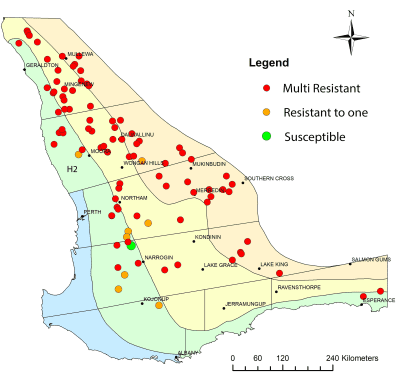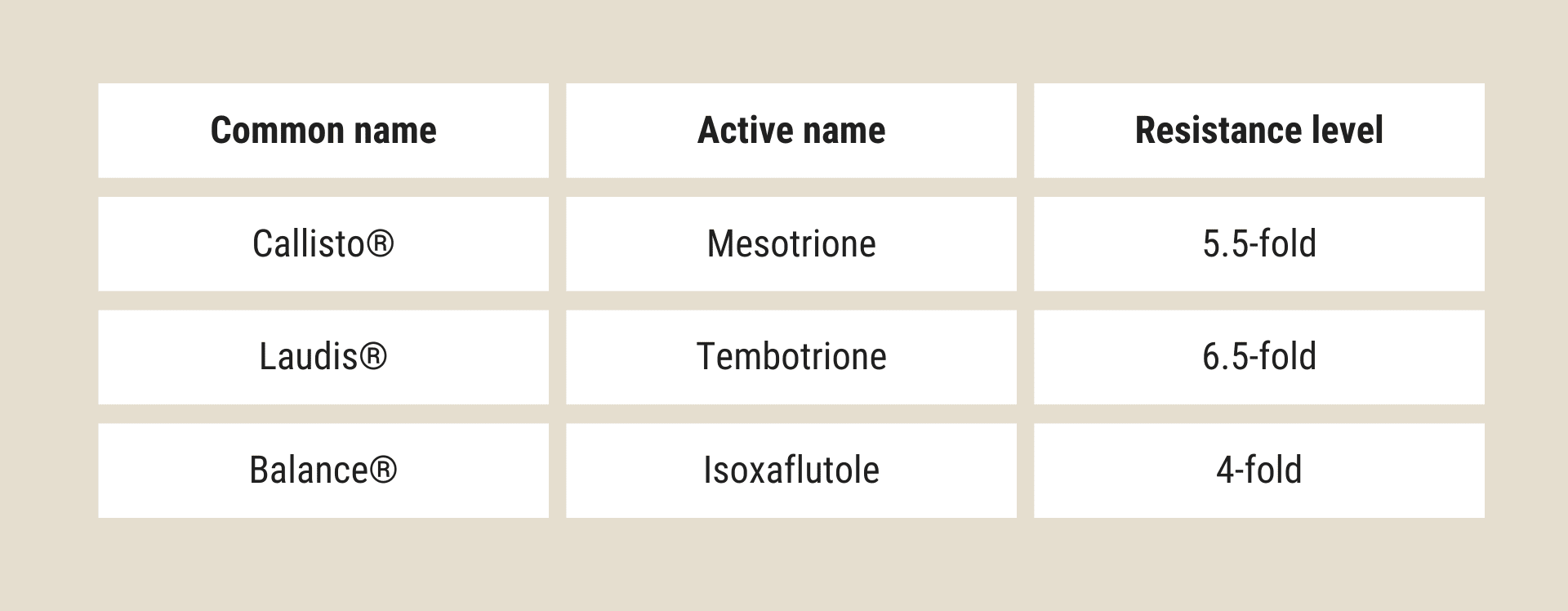
Dr Qin Yu, Dr Heping Han and Dr Huan Lu. Photo: AHRI
IMAGINE if we had a vaccine for COVID-19 when there were just three cases in the world. That would have made for a different global response, I believe.
And if we knew the mechanism of a resistant weed when there were just three populations, would this help us deal with the impending problem? I believe so.
A population of wild radish from Western Australia has been confirmed as the first population with resistance to Hydroxyphenylpyruvate dioxygenase, or HPPD.
This is the research of former Australian Herbicide Resistance Initiative PhD student Huan Lu with help from Dr Qin Yu and others from AHRI.
It’s unlikely that this wild radish was ever sprayed with HPPD herbicides before the resistance was found.
Our old friends, the P450 enzymes, are responsible for this metabolism-based resistance once again.
The resistance level was only 4 to 6.5-fold, so it’s considered low-level resistance, but it’s resistance nonetheless.
This is old news from 2020, but what is new is that the researchers have now identified the specific P450 and other enzymes that were over-expressed to cause this resistance. That’s right, the dimmer switch strikes again.
And you’d be right if you guessed that this population of wild radish is from the northern grainbelt of Western Australia, where all of the good radish comes from.
We know where the resistance is, the specific enzymes involved, and exactly what is causing the over-expression of these enzymes. Pretty impressive response from the research team given that there are only two or three populations of this particular resistance problem on the planet.
Extensive survey
Every five years, Mechelle Owen from AHRI does a massive road trip around the WA grainbelt conducting a random herbicide resistance survey.
Just before harvest 2015, Dr Owen and her team visited about 600 paddocks, collecting 94 wild radish populations. As you can see in the map below, wild radish grows throughout WA, but it really likes the north of the grain-growing region.
You will also notice that all but one of the populations tested is resistant to at least one herbicide.

Populations of radish in 2020 found to be resistant to herbicide. Image: AHRI
One of the populations from the H2 region of WA tested resistant to:
- Atrazine (PSII herbicide)
- Chlorsulfuron (ALS herbicide)
- Diflufenican (PDS herbicide)
- 2,4-D (auxinic herbicide)
The population was treated with the HPPD herbicide Callisto, with active ingredient mesotrione, and 11 plants survived. These plants were grown in pots, cross-pollinated with one another, and the seed collected for further testing.
This population is now known as the first confirmed resistant population to HPPD herbicides. We previously reported on this population here.
There are only two other weed species in the world that have been confirmed resistant to HPPDs: waterhemp and Palmer amaranth from the US.
We now also know that there are two other populations, also from northern WA, that have since been confirmed as resistant to the HPPD herbicide Velocity, with active ingredient pyrasulfotole.
Other HPPDs screened
Three HPPD herbicides were screened in this research, and resistance levels are summarised in the table below.

Table 1: Resistance levels to HPPD herbicides. Source: AHRI
There were also survivors to the HPPD herbicide Velocity, but the data was not published in the paper, and comes from personal communications from Dr Owen.
Given that this population is unlikely to have been sprayed with an HPPD herbicide before it was sampled in 2015, metabolic resistance was strongly suspected.
In this study, the researchers identified two P450 enzymes, CYP704C1 and CYP709B1, plus one other enzyme, that were over-expressed in the resistant population i.e. the dimmer switch was turned up.
Arabidopsis put to test
Arabidopsis is a weed that researchers commonly use as a kind of lab rat.
The researchers put each of the wild radish P450 genes into Arabidopsis to test their effect on resistance to HPPD herbicides to be sure that this was the cause of the resistance.
When they over-expressed CYP709B1 in Arabidopsis, low-level resistance to mesotrione resulted.
When they over-expressed CYP704C1 in Arabidopsis, they found resistance to other HPPD herbicides tembotrione and isoxaflutole.
This is the first time the P450s have been characterised in dicot weedy plants, responsible for resistance to HPPD herbicides, a pretty outstanding achievement given that HPPD resistance was found in dicot plants in the US before it was discovered in Australia.
HPPD herbicides have been extremely important for the control of wild radish in Australia, and we are now starting to see resistance emerge to these herbicides.
It’s amazing that we have this research confirming the resistance mechanism to these herbicides before resistance has become widespread. This will be of enormous help when are faced with more HPPD resistance in the future.
Peter Newman is an AHRI content writer and WeedSmart western extension agronomist.



HAVE YOUR SAY